

Retinopathy of Prematurity (ROP)
Best Advanced Treatment & Expert Care for Retinopathy of Prematurity
Retinopathy of Prematurity (ROP) is a potentially blinding eye disorder that affects premature infants. It occurs when abnormal blood vessels grow in the retina — the light-sensitive tissue at the back of the eye and can lead to retinal detachment and permanent vision loss if not treated in time.
At Ashu Laser Vision and Ashu Eye Clinic, we offer the best advanced treatment for Retinopathy of Prematurity (ROP) in Andheri Mumbai India, combining early diagnosis, cutting-edge technology, and compassionate neonatal care.
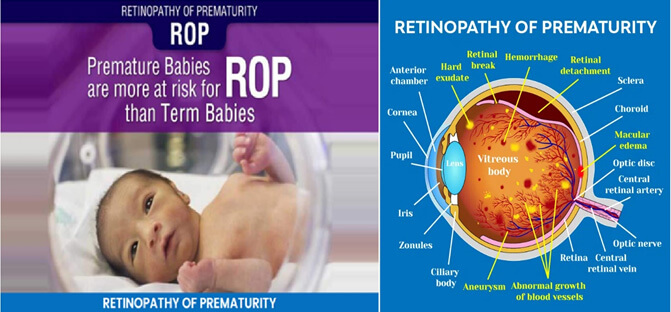
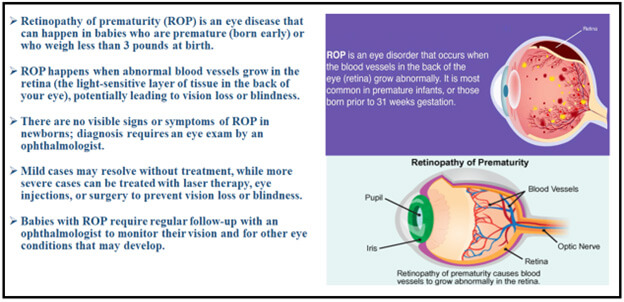
What is Retinopathy of Prematurity (ROP)?
ROP primarily affects premature babies born before 31 weeks of gestation and weighing 1250 grams (2.75 pounds) or less. In a full-term baby, retinal blood vessels fully develop in utero. However, in premature infants, this development remains incomplete, and abnormal vessel growth can result in scarring and detachment of the retina.
If not diagnosed early, ROP can lead to:
- Severe vision impairment
- Childhood blindness
- Long-term retinal complications
Risk Factors for Retinopathy of Prematurity
The primary risk factors include:
- Prematurity (less than 31 weeks)
- Low birth weight (under 1500 grams)
- Prolonged oxygen therapy
- Mechanical ventilation
- Blood transfusions
- Sepsis or other neonatal complications
Causes of ROP
- In premature babies, the retina doesn’t receive adequate oxygen due to underdeveloped blood vessels.
- Abnormal blood vessel growth occurs in response to oxygen fluctuations.
- These fragile vessels may rupture, causing bleeding, scarring, and in severe cases, retinal detachment.
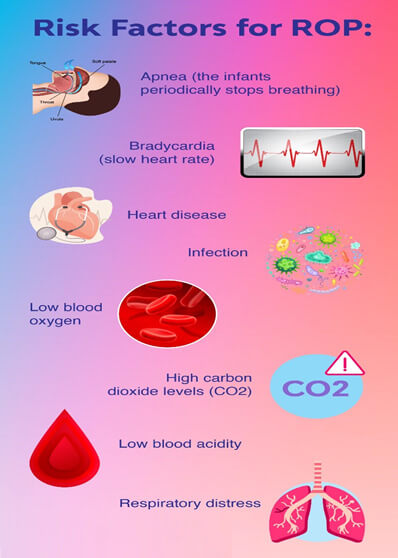
Common Complications of ROP
If left untreated, ROP can lead to:
- Retinal detachment
- Myopia (nearsightedness)
- Amblyopia (lazy eye)
- Strabismus (crossed eyes)
- Glaucoma
Stages of Retinopathy of Prematurity (ROP): A Complete Guide for Parents and Healthcare Providers
Retinopathy of Prematurity (ROP) is a potentially blinding eye disorder that primarily affects premature infants. It occurs when abnormal blood vessels grow in the retina, which can lead to vision loss or blindness if not diagnosed and treated early. Understanding the stages of ROP is essential for early intervention and effective treatment. Below is a breakdown of the five stages of ROP, from mild to severe, using SEO-friendly medical terminology for improved visibility and understanding.
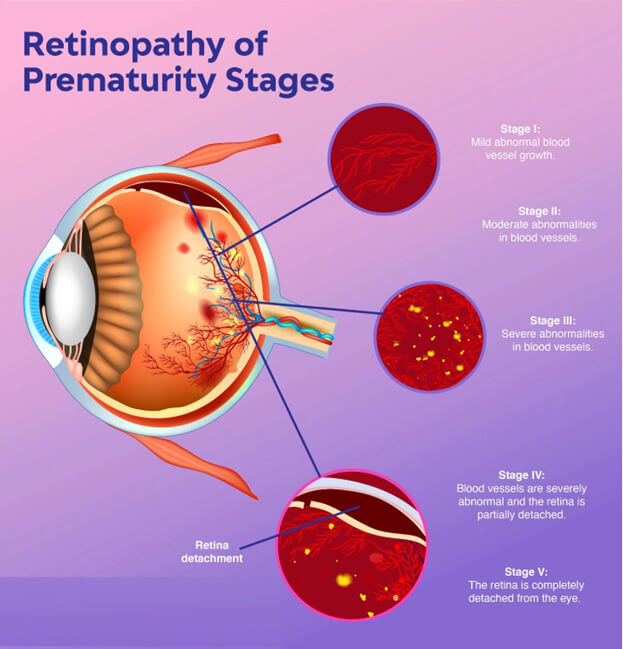
Stage 1 ROP – Mildly Abnormal Blood Vessel Growth
- Description: In this early stage, there is a slight abnormality in the growth of retinal blood vessels.
- Symptoms: Often no visible symptoms.
- Diagnosis: Detected during a routine ROP eye screening for preterm babies.
- Prognosis: Most cases of Stage 1 ROP resolve on their own without treatment.
Stage 2 ROP – Moderately Abnormal Blood Vessel Growth
- Description: In this early stage, there is a slight abnormality in the growth of retinal blood vessels.
- Symptoms: Often no visible symptoms.
- Diagnosis: Detected during a routine ROP eye screening for preterm babies.
- Prognosis: Most cases of Stage 1 ROP resolve on their own without treatment.
Stage 3 ROP – Severely Abnormal Blood Vessel Growth
- Description: Blood vessels grow abnormally into the vitreous (gel-like center of the eye).
- Plus Disease: If swelling and dilation of blood vessels occur, it’s called “Stage 3 with Plus Disease”, indicating urgent need for treatment.
- Treatment Options: Laser therapy, anti-VEGF injections, or cryotherapy.
Stage 4 ROP – Partial Retinal Detachment
- Description: The retina begins to detach partially due to traction from abnormal vessels.
- Subcategories:
- Stage 4A: Partial detachment not involving the macula.
- Stage 4B: Partial detachment involving the macula (central vision).
- Treatment: Vitrectomy surgery may be required to prevent further retinal detachment.
Stage 5 ROP – Total Retinal Detachment
- Description: This is the most severe stage where the retina is fully detached, often leading to complete vision loss.
- Urgency: Requires immediate surgical intervention to attempt vision preservation.
- Prognosis: Visual outcomes are often poor if treatment is delayed.
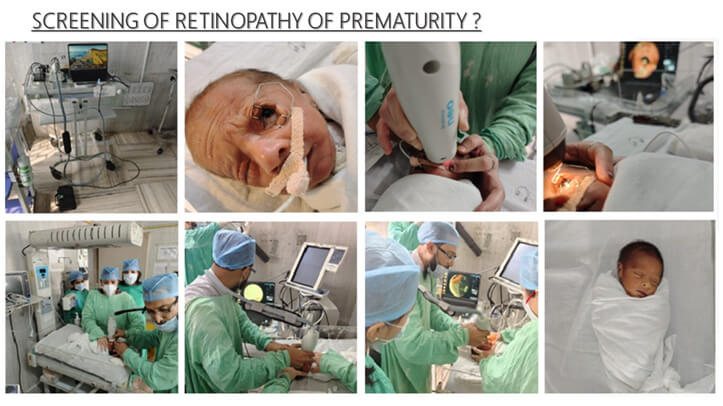
Final Thoughts: Managing ROP with Expert Eye Care
Understanding the different stages of ROP helps parents and healthcare professionals recognize the importance of early intervention. With advances in neonatal eye care and ROP treatment technologies, many infants with ROP can go on to live full lives with preserved vision.
How is ROP Diagnosed?
- ROP screening is typically performed 3–4 weeks after birth.
- Ophthalmologists use an indirect ophthalmoscope or RetCam imaging to examine the retina.
- Screening is mandatory for all premature infants born before 34 weeks or weighing under 2000 grams.
Advanced Treatments for ROP in Andheri Mumbai
At Ashu Laser Vision, we specialize in the latest and safest treatments for ROP, including:
Laser Photocoagulation in Retinopathy of Prematurity (ROP): A Vision-Saving Treatment for Preterm Infants
Retinopathy of Prematurity (ROP) is a serious eye condition affecting premature infants, where abnormal blood vessels grow in the retina and may lead to retinal detachment or blindness. One of the most effective treatments for this condition is laser photocoagulation—a proven method to halt the progression of ROP and protect a baby’s vision.
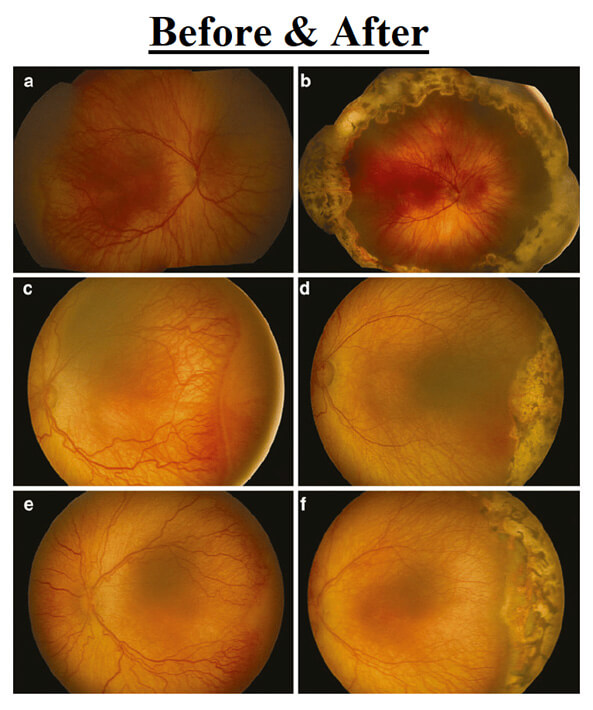
What Is Laser Photocoagulation in ROP?
Laser photocoagulation for ROP is a specialized retinal laser treatment that uses focused laser energy to ablate (burn) the avascular peripheral retina. This treatment prevents the abnormal growth of blood vessels that could otherwise lead to vision-threatening complications.
When Is Laser Photocoagulation Needed in ROP?
Laser photocoagulation is typically used in Stage 3 ROP with Plus Disease, which is characterized by:
- Abnormal blood vessel growth in the retina
- Vessel dilation and tortuosity (Plus Disease)
- High risk of retinal detachment if untreated
Early intervention during this critical stage greatly improves visual outcomes.
How the Procedure Works
- Performed in a neonatal intensive care unit (NICU) or an ophthalmology surgical suite
- The baby is given sedation or anesthesia for comfort
- A specialized laser is applied to the peripheral retina to stop abnormal vascular development
- Duration: Around 30–60 minutes per eye
Benefits of Laser Treatment in ROP
- Highly effective in preventing blindness in premature infants
- Long-term stabilization of the retina
- Can be completed in one session for many cases
- Standard of care worldwide for treatable ROP stages
Risks and Considerations
While laser therapy for ROP is generally safe, some potential risks include:
- Peripheral vision loss (due to ablation of peripheral retina)
- Need for repeat treatment in some cases
- Possible complications if ROP is diagnosed too late
This makes early screening and timely referral absolutely essential.
Laser Photocoagulation vs. Anti-VEGF Injections in ROP
While anti-VEGF injections are emerging as an alternative in some cases, laser photocoagulation remains the gold standard for many forms of threshold ROP, particularly when long-term safety and disease regression are priorities.
Final Thoughts: Early Laser Treatment Saves Sight
Laser photocoagulation for ROP is a critical tool in neonatal ophthalmology that can save the vision of thousands of premature babies each year. When ROP is diagnosed early and treated promptly, the risk of permanent blindness is significantly reduced.
If your baby was born prematurely, ask your doctor about ROP eye screening and whether laser therapy may be needed.
Retinal Cryotherapy for Retinopathy of Prematurity (ROP): A Vision-Saving Procedure for Preterm Infants
Retinopathy of Prematurity (ROP) is a serious retinal condition that affects premature babies, causing abnormal blood vessel growth in the retina. One of the earliest and most established treatments for advanced ROP is retinal cryotherapy — a procedure that uses extreme cold to halt disease progression and prevent retinal detachment.
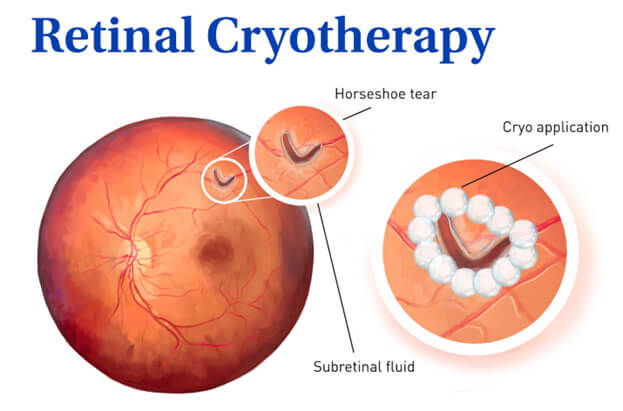
What Is Retinal Cryotherapy?
Retinal cryotherapy is a treatment that uses freezing temperatures to destroy the peripheral areas of the retina where abnormal blood vessels grow in ROP. This helps prevent further damage and reduces the risk of blindness in premature infants.
When Is Cryotherapy Used in ROP?
Cryotherapy is typically used in:
- Stage 3 ROP with Plus Disease
- Cases where laser photocoagulation is not available or feasible
- Eyes with media opacity (e.g., hemorrhage) where laser cannot penetrate
Although laser treatment is now more common, cryotherapy remains an alternative in certain cases and settings.
How Retinal Cryotherapy Works
- Performed under general anesthesia in a neonatal surgical setting
- A cryoprobe is applied externally to the eye to reach the retinal periphery
- Freezing creates controlled retinal scarring to stop abnormal blood vessel growth
- Procedure time: 30–60 minutes per eye
Benefits of Cryotherapy in ROP
- Proven to reduce risk of retinal detachment
- Can be used when laser therapy is not possible
- Long-standing record of effectiveness in vision preservation
- Portable equipment makes it accessible in low-resource settings
Risks and Side Effects
Although effective, retinal cryotherapy may have some risks:
- Increased inflammation and discomfort compared to laser
- Possible peripheral visual field loss
- May cause temporary eyelid swelling or redness
- In some cases, it may need to be combined with vitrectomy in advanced stages
Cryotherapy in the History of ROP Treatment
Cryotherapy played a major role in the landmark CRYO-ROP study, which demonstrated that timely treatment could significantly reduce the rate of blindness in premature infants with threshold ROP. Though laser photocoagulation is now the preferred method in many centers, cryotherapy remains an important tool in specific scenarios.
Final Thoughts: Retinal Cryotherapy Remains a Valuable ROP Treatment
While laser therapy is now more commonly used, retinal cryotherapy is still a viable and effective treatment for Retinopathy of Prematurity, particularly when laser access is limited or conditions are not ideal for laser application. Early ROP screening and timely referral to a pediatric retina specialist can ensure the best possible outcome for your baby’s vision.
Anti-VEGF Injections for Retinopathy of Prematurity (ROP): A Breakthrough in Infant Eye Care
Retinopathy of Prematurity (ROP) is a serious eye condition that affects premature infants, especially those born before 31 weeks of gestation. It occurs when the blood vessels in the retina, the light-sensitive tissue at the back of the eye, develop abnormally. If left untreated, ROP can lead to vision impairment or even blindness. Fortunately, advances in treatment for ROP have made it possible to preserve vision in many affected infants, with Anti-VEGF injections emerging as one of the most effective options.
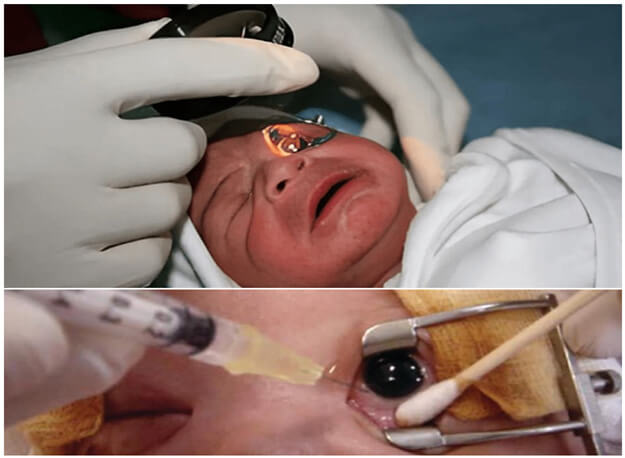
What Are Anti-VEGF Injections?
Anti-VEGF (Vascular Endothelial Growth Factor) injections are medications that block the action of VEGF, a protein that promotes the growth of abnormal blood vessels in the eye. In the case of ROP, these blood vessels can cause retinal damage, leading to severe visual impairment. Anti-VEGF treatments work by inhibiting this protein, preventing the growth of abnormal vessels and thereby reducing the risk of retinal detachment and permanent blindness in preterm infants.
How Anti-VEGF Injections Help Treat Retinopathy of Prematurity
In infants diagnosed with ROP, particularly those in the more advanced stages, Anti-VEGF injections are considered a first-line treatment option. They can significantly reduce the need for more invasive procedures such as laser therapy or surgical intervention. The benefits of Anti-VEGF therapy for ROP include:
- Reduced Risk of Retinal Detachment: Anti-VEGF injections help stabilize the retina, preventing detachment, which can result in blindness.
- Minimized Need for Surgery: Unlike laser therapy, which requires targeted burning of the retina, Anti-VEGF injections are non-invasive, reducing the risk of long-term complications.
- Faster Visual Recovery: Infants who receive Anti-VEGF injections often show quicker improvement in vision compared to those who undergo laser treatment.
- Easier on Infant Health: The treatment is generally well-tolerated, and the non-invasive nature means that it’s less stressful for the infant compared to other procedures.
Why Anti-VEGF Treatment is Revolutionizing ROP Care
Anti-VEGF injections have become a revolutionary treatment for retinopathy of prematurity due to their remarkable ability to target the underlying mechanism of the disease — abnormal blood vessel growth. Prior to Anti-VEGF therapy, laser photocoagulation and cryotherapy were the main options, both of which involved significant risks, especially in fragile infants. With Anti-VEGF injections, the risk of these complications is greatly reduced, making it a safer and more effective solution.
The introduction of Anti-VEGF therapy has not only improved the success rates in treating ROP but has also led to a shift in treatment protocols globally. It’s considered by many specialists as the gold standard for managing stage 3+ ROP (severe stage ROP) in preterm infants, with outcomes that include reduced risk of vision loss and improved eye health.
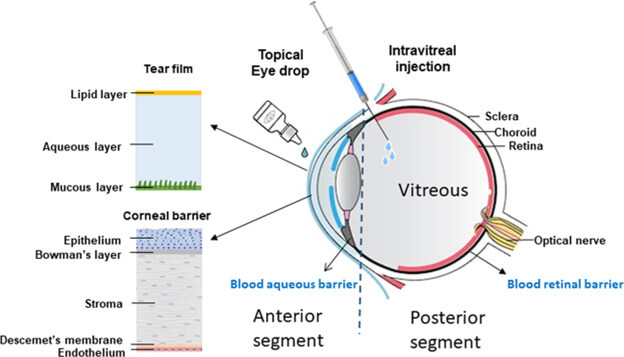
Types of Anti-VEGF Injections Used for ROP
Benefits:
- High efficacy in preventing blindness from ROP.
- Reduced frequency of follow-up treatments compared to laser therapy.
- Minimized systemic side effects, as the injection is localized to the eye.
Potential Risks:
- Though rare, there can be side effects such as infection, increased intraocular pressure, or inflammation.
- The long-term effects of Anti-VEGF treatment in premature infants are still being studied, particularly concerning growth and development, as VEGF plays a role in other aspects of bodily development.
The Future of Anti-VEGF Treatment for ROP
While Anti-VEGF injections have already proven to be a breakthrough in treating Retinopathy of Prematurity, ongoing research continues to explore the optimal treatment protocols, dosages, and long-term impacts of this therapy. The introduction of Anti-VEGF therapy has sparked hope for many parents and healthcare providers in improving the quality of life and vision for premature infants.
Conclusion: A Vital Advancement in ROP Treatment
The use of Anti-VEGF injections for Retinopathy of Prematurity has significantly improved the prognosis for infants diagnosed with this potentially blinding condition. With its ability to target abnormal blood vessel growth in the retina and offer a less invasive treatment option, Anti-VEGF therapy is considered a game-changer in pediatric ophthalmology. Early detection and timely intervention remain key to achieving the best outcomes for premature infants affected by ROP.
If you or someone you know has an infant at risk for Retinopathy of Prematurity, it’s essential to work closely with a pediatric ophthalmologist to determine the best course of treatment. With advancements like Anti-VEGF therapy, the future of eye health for premature babies is brighter than ever.
Vitrectomy for Advanced Stages of Retinopathy of Prematurity (ROP): A Life-Saving Surgical Solution
Retinopathy of Prematurity (ROP) is a sight-threatening condition that primarily affects premature infants, often leading to blindness if not diagnosed and treated promptly. While early stages of ROP can be managed with Anti-VEGF injections or laser therapy, advanced stages of the condition — especially stage 4 and stage 5 ROP — often require more aggressive intervention, such as vitrectomy. This surgical procedure plays a pivotal role in preventing permanent vision loss in infants suffering from severe ROP complications.
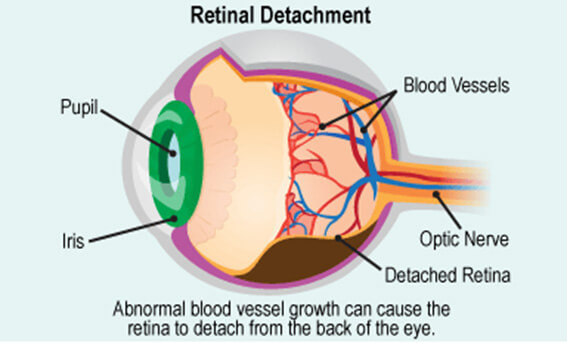
What is Vitrectomy for Advanced ROP?
Vitrectomy is a surgical procedure that involves removing the vitreous gel from inside the eye to treat severe cases of Retinopathy of Prematurity (ROP). In advanced ROP, the abnormal blood vessel growth in the retina can lead to retinal detachment, fibrous tissue formation, or hemorrhaging within the eye. These conditions pose a significant threat to an infant’s vision. Vitrectomy surgery is used to treat these advanced complications by removing the vitreous (the gel-like substance inside the eye), relieving tension on the retina, and enabling doctors to perform additional treatments like retinal reattachment and laser therapy.
Why is Vitrectomy Necessary for Advanced ROP?
When ROP progresses to its later stages, such as stage 4 or stage 5, the condition becomes more complicated. In these stages, the abnormal blood vessels cause the retina to detach or form scar tissue that distorts the retina, often leading to complete or partial blindness. Vitrectomy is required to address these severe complications and save vision in infants diagnosed with advanced ROP. The primary issues treated by vitrectomy surgery include:
- Retinal Detachment: In stage 4 ROP, the retina becomes detached from the back of the eye, which can cause permanent vision loss. Vitrectomy helps to reposition the retina and promote its reattachment.
- Fibrous Tissue Formation: In stage 5 ROP, fibrous tissue grows over the retina and distorts its structure, leading to complete retinal detachment. The vitrectomy procedure removes the vitreous and the scar tissue, allowing surgeons to attempt reattaching the retina.
- Vitreous Hemorrhage: Severe bleeding in the vitreous cavity can block vision. Vitrectomy removes the blood-filled vitreous gel and enables the surgeon to stop the bleeding.
How Does Vitrectomy for ROP Work?
The vitrectomy surgery for advanced Retinopathy of Prematurity is typically performed under general anesthesia. The procedure involves the following key steps:
- Removal of the Vitreous: The first step is to make a small incision in the eye to remove the vitreous gel that may be pulling on the retina and contributing to retinal detachment. This allows the surgeon to access and treat the retina directly.
- Treatment of Retinal Detachment: After removing the vitreous, the surgeon can then attempt to reattach the retina using different techniques, such as laser photocoagulation, cryotherapy, or in some cases, gas or silicone oil injection to hold the retina in place while it heals.
- Scar Tissue Removal: In stage 5 ROP, the surgeon will carefully remove any scar tissue that may have formed over the retina. The removal of these fibrous tissues reduces the risk of further retinal detachment.
- Post-Surgery Care: After the procedure, the infant may be required to remain in a special position to keep the retina in place, especially if a gas bubble or silicone oil has been used. The recovery process is closely monitored by a pediatric ophthalmologist.
Benefits of Vitrectomy for Advanced ROP
1. Saving Vision: The most important benefit of vitrectomy for ROP is its ability to save or restore vision in infants who would otherwise face permanent blindness. In cases of stage 4 and stage 5 ROP, where other treatments may not be effective, vitrectomy offers the best chance of visual recovery.
2. Addressing Retinal Detachment: Vitrectomy allows for a direct repair of retinal detachment, which is often the most serious complication of advanced ROP. By removing the vitreous and reattaching the retina, vision can often be preserved, even in cases where laser therapy or injections might not be enough.
3. Reducing Scar Tissue Formation: By removing scar tissue and preventing further traction on the retina, vitrectomy can help preserve retinal health and reduce the risk of future complications.
4. Minimizing Long-Term Impact: Early intervention with vitrectomy can help minimize the long-term impact of ROP on a child’s vision and overall eye health. Infants who undergo vitrectomy surgery may have a better chance at leading a life with functional vision.
Risks and Considerations of Vitrectomy for ROP
Like any surgery, vitrectomy carries certain risks. Although the procedure is generally safe, parents and caregivers should be aware of potential complications, which include:
- Infection: As with any surgical procedure, there is a risk of infection within the eye.
- Increased Intraocular Pressure: Elevated pressure within the eye may occur after vitrectomy, requiring management with medication or additional treatments.
- Cataract Formation: The procedure may lead to the development of cataracts, especially in infants who undergo the surgery at a very young age.
- Retinal Re-detachment: In some cases, the retina may detach again after surgery, requiring further intervention.
- Glaucoma: Although rare, vitrectomy can sometimes lead to an increase in intraocular pressure, which can result in glaucoma.
Who Needs Vitrectomy for Advanced ROP?
Vitrectomy is typically recommended for infants with stage 4 or stage 5 ROP, where retinal detachment or severe scarring has already occurred. These are the most advanced and dangerous stages of ROP, where immediate intervention is necessary to prevent permanent vision loss.
It is crucial that premature infants receive regular eye screenings to detect early signs of Retinopathy of Prematurity, as timely intervention in the earlier stages often leads to better outcomes. If vitrectomy surgery is required, it is performed by a skilled pediatric retinal surgeon who specializes in ROP management.
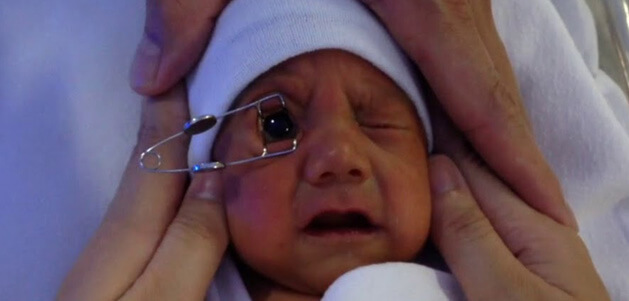
Post-Surgery Care and Recovery
After vitrectomy surgery for ROP, infants are carefully monitored in a neonatal intensive care unit (NICU) or specialized pediatric care unit. Post-surgery care typically involves:
- Follow-up eye exams: Frequent visits to the ophthalmologist to monitor the progress of the retina’s healing and ensure no further complications develop.
- Positioning: Infants may be instructed to stay in specific positions to help hold the retina in place while it heals, particularly if a gas or silicone oil bubble is used.
- Antibiotics: To prevent infection, antibiotic eye drops may be prescribed.
The Future of Vitrectomy for ROP Treatment
As surgical techniques continue to evolve, vitrectomy for advanced ROP is becoming increasingly refined. New tools, advanced imaging techniques, and more effective Anti-VEGF treatments are all contributing to better outcomes for infants with severe ROP. Ongoing research and clinical trials will likely continue to improve the safety and success rates of vitrectomy surgery for ROP.
Conclusion
Vitrectomy for advanced Retinopathy of Prematurity is a critical procedure for infants diagnosed with stage 4 and stage 5 ROP. By removing the vitreous, repairing retinal detachment, and removing scar tissue, this surgical intervention offers hope for preserving vision and improving the quality of life for affected infants. Early diagnosis and intervention remain key to successful outcomes, and collaboration with a pediatric retinal specialist is essential to determine the best treatment approach.
Final Thoughts: Retinal Cryotherapy Remains a Valuable ROP Treatment
Led by Dr. Shahnawaz Kazi, Ashu Eye Clinic is one of the most trusted centers for ROP treatment in Mumbai. With over 16 years of expertise in pediatric retinal surgery and neonatal care, our clinic offers:
- Neonatal-compatible laser systems
- Child-safe anesthesia protocols
- NICU-integrated ophthalmic evaluations
- Individualized monitoring plans for premature infants
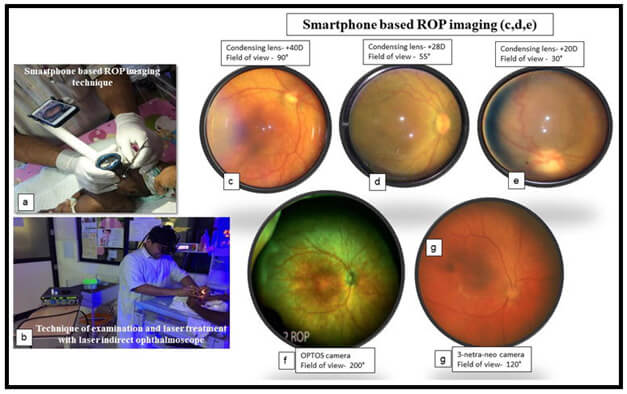
Parental Support & Follow-up
We offer compassionate counseling and long-term follow-up plans to ensure your child’s visual development is closely monitored even after ROP is treated.
Why Choose Ashu Laser Vision for ROP in Andheri Mumbai?
- Pediatric retina specialist with vast surgical experience
- NICU & pediatric ophthalmology integration
- State-of-the-art equipment for safe infant screening
- Proven track record of successful ROP interventions
- Convenient location in Andheri West, Mumbai
Expert Retinopathy of Prematurity ROP Treatment by Dr. Shahnawaz Kazi – Leading Pediatric Retina Specialist in Mumbai, India
With over 17 years of specialized experience, Dr. Shahnawaz Kazi is a highly respected name in the field of Retinopathy of Prematurity (ROP) treatment in Mumbai, India. Having successfully diagnosed and treated hundreds of premature infants affected by ROP, Dr. Kazi combines clinical excellence with compassionate care. His expertise spans the entire spectrum of ROP management — from early retinal screenings in NICUs to advanced laser therapy, anti-VEGF injections, and vitreoretinal surgeries in critical cases. Parents across Andheri, Mumbai and beyond trust him for his precision, commitment, and outstanding outcomes. Under his care at Ashu Laser Vision and Ashu Eye Clinic, premature infants receive the best advanced ROP treatment with cutting-edge technology and a personalized approach for long-term visual development.
Advanced Care for Retinopathy of Prematurity (ROP) in Andheri, Mumbai
Retinopathy of Prematurity (ROP) is one of the most serious pediatric retinal disorders, and timely detection is essential for preserving a baby’s vision. At Ashu Laser Vision and Ashu Eye Clinic in Andheri, Mumbai, we specialize in the early screening, diagnosis, and treatment of ROP using the latest techniques in neonatal ophthalmology. Our clinic is equipped with RetCam imaging, indirect ophthalmoscopy, and cutting-edge ROP laser and injection therapy systems, making it a leading destination for ROP treatment in Mumbai.
Why Early Screening for ROP Is Crucial
Premature infants often spend time in neonatal intensive care units (NICUs), where they may receive supplemental oxygen therapy — a known risk factor for abnormal retinal blood vessel growth. If not monitored properly, these fragile vessels can cause scarring, retinal detachment, and even permanent blindness. That’s why early ROP screening within 3–4 weeks of birth is a global standard of care.
At our ROP specialist center in Andheri, Mumbai, our team, led by Dr. Shahnawaz Kazi, performs timely screenings in coordination with NICU teams to ensure prompt intervention when needed.
Ultra-Modern & Advanced Diagnostic Tools for ROP in Mumbai
We offer advanced diagnostic modalities for accurate detection of ROP:
- Digital RetCam Imaging
- Fluorescein Angiography
- Portable Binocular Indirect Ophthalmoscopy
- OCT for pediatric retina evaluation
This ensures that infants receive early-stage diagnosis and accurate staging for timely management of ROP.
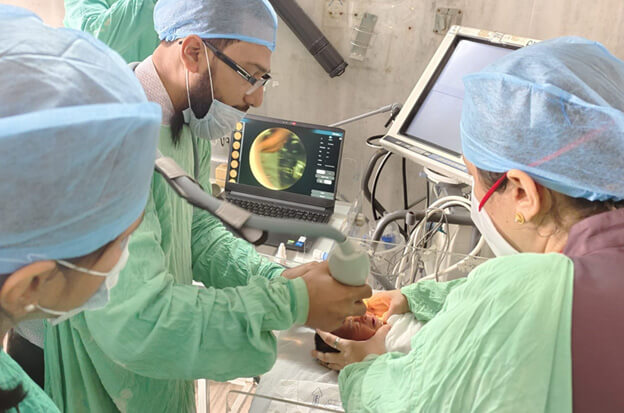
Ultra-Modern & Advanced Diagnostic Tools for ROP in Mumbai
We offer advanced diagnostic modalities for accurate detection of ROP:
- Digital RetCam Imaging
- Fluorescein Angiography
- Portable Binocular Indirect Ophthalmoscopy
- OCT for pediatric retina evaluation
This ensures that infants receive early-stage diagnosis and accurate staging for timely management of ROP.
Why Choose Ashu Laser Vision for ROP Care?
- Led by Shahnawaz Kazi, one of Mumbai’s leading ROP specialists with over 17 years of experience in neonatal retina care.
- Located conveniently in Andheri, Mumbai, serving patients across Western Mumbai, Navi Mumbai, and Central Mumbai.
- Trusted by top pediatricians and NICUs for ROP referrals and surgical care.
- Dedicated pediatric eye care team and NICU collaboration for complete neonatal visual health.
Frequently Asked Questions (FAQs) About Retinopathy of Prematurity (ROP)
ROP is a potentially blinding eye disorder that affects premature infants. It involves abnormal blood vessel growth in the retina, which can lead to scarring and retinal detachment if untreated.
Babies born before 31 weeks of gestation or weighing less than 1500 grams are at the highest risk. However, babies born even slightly later may still be affected.
ROP is caused by abnormal retinal blood vessel development due to premature birth. Fluctuating oxygen levels and underdeveloped retinal blood vessels can trigger abnormal growth and bleeding.
ROP is classified into 5 stages:
- Stage 1: Mild abnormal blood vessel growth
- Stage 2: Moderate abnormal growth
- Stage 3: Severe abnormal growth
- Stage 4: Partial retinal detachment
- Stage 5: Total retinal detachment
ROP is diagnosed through a retinal exam performed by a pediatric retina specialist using an indirect ophthalmoscope or a Retina Cam imaging system.
ROP screening should typically begin 3–4 weeks after birth for babies born prematurely. Early detection is key to preventing vision loss.
Yes, if left untreated, ROP can cause permanent vision impairment or total blindness, especially in advanced stages.
Treatments include:
- Laser therapy
- Cryotherapy
- Anti-VEGF injections (e.g., Avastin, Lucentis)
- Vitrectomy surgery in advanced cases
No, treatments like laser and injections are performed under gentle sedation or anesthesia to ensure the baby’s comfort and safety.
Yes, Ashu Laser Vision and Ashu Eye Clinic in Andheri, Mumbai offers expert ROP care, led by Dr. Shahnawaz Kazi, a pediatric retina specialist with 16+ years of experience.
Laser treatment typically takes 20–40 minutes, while injection treatments are quicker. Vitrectomy may take longer depending on the severity.
Mild ROP (Stages 1 and 2) may regress on its own. However, moderate to severe cases (Stages 3–5) require active treatment to prevent blindness.
With timely diagnosis and intervention, over 90% of babies with ROP can retain useful vision and avoid serious complications.
Follow-up visits depend on the stage of ROP but are usually scheduled every 1–2 weeks until the retina has fully developed.
Children treated for ROP may have:
- Myopia (nearsightedness)
- Strabismus (crossed eyes)
- Amblyopia (lazy eye)
- Higher risk of retinal issues later in life
Yes, especially in aggressive posterior ROP (AP-ROP), recurrence can occur. Regular follow-ups are essential for monitoring progress.
Yes, many babies with mild or treated ROP go on to have normal or near-normal vision, especially when treated early and followed up appropriately.
Both are effective. Laser therapy is time-tested, while anti-VEGF injections are newer and effective in aggressive cases. The choice depends on the stage and zone of ROP.
ROP screening often takes place in the NICU, where eye specialists collaborate with neonatologists to monitor high-risk infants from birth.
Visit Ashu Laser Vision and Ashu Eye Clinic in Andheri Mumbai India, known for delivering advanced, compassionate, and specialized care for ROP and other pediatric retinal conditions.
Best ROP Specialist Near Me – Visit Us in Andheri, Mumbai
If you’re searching for the best ROP specialist in Mumbai or need advanced eye care for premature infants, Ashu Laser Vision and Ashu Eye Clinic in Andheri is your trusted destination. We are committed to helping your baby see the world clearly — from day one.
📞 Book a consultation today for ROP screening or treatment in Mumbai.

